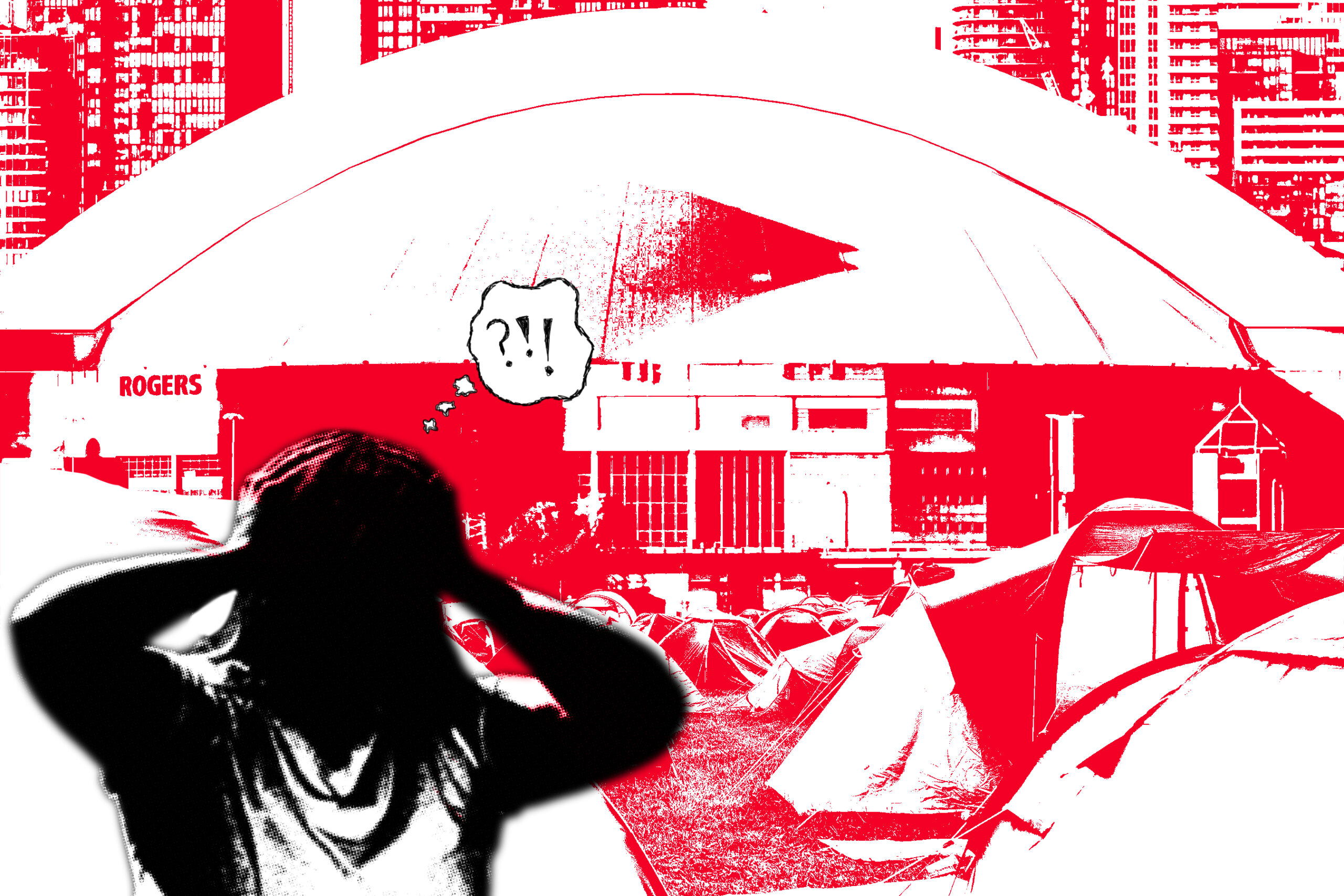Camping out for concerts is becoming increasingly popular at a time when houseless encampments are slowly outlawed across the city

By Julian Sharma
You’ve just gotten tickets to your most anticipated concert of the year. You fought in what many online describe as the Ticketmaster war and you won! You’ll be in the pit for the Billie Eilish concert at the Scotiabank Arena in Toronto. After purchasing the tickets, you head online to see what the reactions are and what people are saying about the concert. Opening TikTok, you find hundreds, if not thousands, of people planning to sleep on the streets days before the concert. People are buying tents, making schedules and lining up on the pavement outside the concert venue hours before the show.
For many, attending concerts in recent years is less of a fun-filled activity with friends and more of a high stakes experience to ensure they get the best spots in the arena. General admission ticket holders are determined to be as close to their favourite artists as possible, no matter what it takes. They’ll do anything for the chance to be four feet away from the person they paid hundreds and sometimes thousands of dollars to see — and that includes camping out on the street.
The day finally arrives and you reach the venue, bursting at the seams with anticipation. Once you get to the lineup, however, something feels off. There are no fans there with poster boards or shiny new sleeping bags.
Instead, you find a bylaw officer standing over an encampment belonging to an unhoused person, directing them to dismantle their tent and remove their personal belongings from the park. You stand there, watching as a man’s home and place of rest is removed. You clutch your tent a little closer to your chest.
This harsh reality check, albeit the hypothetical of an all-too-common occurrence, are the stark living conditions for unhoused people in big cities such as Toronto. As a popular destination for a large portion of the country’s stadium tours, these big concerts often come and go, trailing behind repercussions for unhoused people to relocate.
After Taylor Swift’s November 2024 reign over Toronto, five people who were staying in tents near the Rogers Centre were given spaces in Toronto shelters in order “to help ensure their safety,” a city spokesperson claimed.
These were five out of thousands of unhoused people in Toronto who were prioritized by the city in order to make the area more palatable to visitors.
In a feature article published by The Local in 2024, outreach worker Natum Mann stated that upon encampment evictions, the city doesn’t give unhoused people any good alternatives. Shelters are overcrowded, which contributes to an unsafe environment for people seeking aid.
Jennifer Jewell, an unhoused disabled woman, spoke to the Toronto Star in 2021, detailing the tragedy she witnessed while staying at the Bond Place Hotel, a temporary shelter that has since closed down. Her neighbour, Bridget, passed away while at the shelter. Jewell expressed concern over how the situation was handled, explaining that Bridget was treated unfairly by the workers of the shelter. Jewell’s experience was not an isolated incident. A study conducted by the Centre for Addiction and Mental Health (CAMH) in April 2024 showed a 283 per cent increase in interpersonal violence in Toronto shelters between the years of 2011 to 2021.
Forced eviction and removal of personal belongings can traumatize a person and strain the already difficult relationship between unhoused people and the city.
“[The city] is very conscious of their self-image too — like what’s the image of Toronto?” says David Reycraft, the senior director for programs and services at Eva’s Initiatives — a social services organization for unhoused youth in Toronto. “We don’t want to be seen as this city that has homeless encampments on every street corner.”
Although that might just be what Toronto is, if not the entirety of Ontario.
A study released by the Association of Municipalities of Ontario (AMO) in January 2025 says that over 80,000 people in Ontario were unhoused last year. Since 2022, this number has increased by 25 per cent.
The climbing statistics surrounding unhoused people are clashing with the increase of camping out for concerts, a culture that has surged in popularity in recent years.
Now, this isn’t a new trend by any means. People have been camping for concerts for decades, indicated by an ARS Open Forum titled Tell me about camping out for concerts dating back to 2005. However, with the introduction of social media into concert culture, the pressure surrounding the trend has shifted, along with the intensity.
Jade Woonsam, a first-year Marketing Management student at Toronto Metropolitan University, says that social media creates a fear of missing out (FOMO) among fans. “When you see it online, then it kind of builds that scare, like, oh people are lining up already? Maybe I should go do that too,” she pointed out.
The intersection of two topics that are seemingly on two ends of a spectrum leaves much to be considered about the perception and treatment of unhoused people in cities like Toronto. In the context of the recent uproar in concert camping, it begs the question: at what point does camping out stop being a fun trend teenagers on TikTok are participating in and starts being dangerous or unlawful? Who gets to decide that? And why?
This isn’t to say that everybody supports camping out or that everybody who camps out is ignorant of the issues unhoused people face. Many criticisms have been made of the trend all over the internet. A video essay by Jasmine Zade created in 2022, titled camping for concerts is getting out of hand highlights several concerns about the trend. These concerns include hygiene and self-care while camping, disrespecting the environment where people are camping out and ignoring the fact that unhoused people sleep on the same streets with nowhere else to go.
With all these controversies and criticisms, why are people doing it in the first place?
When speaking to Tess Welbes and Sage Stoyak, university students who attended the Billie Eilish concert in Toronto in the Fall, some of the reasoning became a little clearer. “It was just a very communal, nice experience,” Welbes says. “We met so many people.”
Both Welbes and Stoyak lined up early for the concert, a decision that Stoyak says made her more excited for the concert. The pair met around a dozen people in the lineup, making friends who all were part of a shared experience. Community isn’t all of it, though.
Ticketmaster’s dynamic pricing is another factor which exacerbates the lineups to form earlier and earlier, according to Welbes. She’s noticed that if the show is for someone who’s getting increasingly popular, the prices will be unattainably inflated to maximize profit. Although dynamic pricing must be approved by the performing artist and therefore is not entirely in the hands of Ticketmaster, many fans like Welbes find themselves frustrated by the prices and lining up earlier to see if they can secure cheaper tickets or better spots.
While lining up, Welbes and Stoyak say that the entire system of the lineup was incredibly disorganized. Some fans even got kicked out of the venue because they were giving out fake wristbands in the lineup. There were people crowding the sidewalk and lining up next to the ongoing construction site and some were even in tents for the second night of the concert under the Gardiner at 7 a.m. the day before.
“If you can afford a Taylor Swift concert, you’re not camping out because you’re poor and don’t have access to the social determinants of health.”
Evidently, practices like early lineups and camping out inherently lack proper organization and put a lot of stress on concert venues and their staffs. Yet it continues to become more widespread as bigger artists embark on stadium tours.
Despite these risks, Welbes and Stoyak mention that passersby were excited to see the concertgoers lined up on the sidewalk. People were waving, smiling and asking which artist they were going to see that night.
Fandom spaces on the internet have embraced this camping culture with open arms. Fans are writing how-to guides on how to prepare and camp out on the streets. These guides detail tips like “make sure to stay warm if you’re camping during the winter,” even suggesting bringing newspapers to sit on.
If fans camping out are given how-to guides, encouraging comments from passersby who notice their devotion and praise their strength and resilience, why can’t the same be said for unhoused people who are condemned for it?
Unhoused people building encampments in parks for their own safety are commonly ordered to leave and are placed in shelters on occasion. In these instances, they are usually ordered to do so with short notice and oftentimes feel pressured into it. This is outlined in a case study of Toronto, ‘A Human Rights Analysis of Encampments in Canada,’ conducted by the Canadian Human Rights Commission.
Reasons cited for encampment removal are “health, fire, and safety concerns.” In the study, it’s said that the government failed to provide basic resources such as clean water, sanitation facilities, electricity and heat. The lack of these services violates the well-being and dignity of the unhoused people in these encampments.
Reycraft points out the disparities between the unhoused people and the concertgoers. “If you can afford a Taylor Swift concert, you’re not camping out because you’re poor and don’t have access to the social determinants of health.”
These class differences are what drive the varied treatments and public attitudes toward both groups. The people camping out are, more often than not, young people who have a place to go home to after the concert is over. They come from a place of privilege, Reycraft points out, to not have to think about people on the other end of the spectrum who don’t necessarily have a warm place to sleep when nighttime falls.
The dissonance in these attitudes are an indicator of how accustomed the general population in bigger cities, like Toronto, are to the unhoused crisis and to seeing people on the streets.
With the worsening statistics concerning unhoused people in Ontario and decisions made by Doug Ford’s conservative legislation to try and put a stop to encampments in the province, outreach workers are noticing a lack of empathy concerning unhoused people and the injustices they face.
Although Reycraft believes the city’s encampment policies are generally good at finding people housing, the stigma remains.
“There’s a growing intolerance in our city about the encampments and about homeless people generally,” he said.
This intolerance is only exacerbated by sensationalized rhetoric circulating through the pulse of downtown. Specifically on the Toronto Metropolitan University (TMU) campus, some students have cited “safety concerns” due to the large unhoused population which organically exists on the outskirts of the campus, just as the rest of the downtown core. These misconceptions lead students to fear unhoused people in any context, adding to the stigma that could obstruct them from accessing resources and care.
As people continue to camp out and unhoused statistics surge at disproportionate rates, there must be actions set in motion to support unhoused people in the city. The peddling won’t arrive solely by municipal authorities, but through us, as everyday civilians, who fleetingly pass by our unhoused neighbours on the daily.
Having worked with multiple organizations involved in outreach for unhoused people in Toronto, Reycraft’s perspective offers more nuance to the situation. He understands the lack of space in Toronto shelters is a real issue, but their struggles don’t end there, which is something people might not realize.
Reycraft suggests an intervention, of sorts, to help swing the pendulum — even by talking to the people camping out for concerts, who might not have considered how their choices impact unhoused folks. If they can understand the systemic pathologization of unhoused people and how close any working-class person is to living that reality, they may be able to gain some perspective.
Young people can often find themselves without housing to flee abuse or due to losing a job and situations completely out of their control. Additionally, any woman who finds herself unhoused for any period of time will be subject to sexual violence. These are the dangers and obstacles faced by unhoused people everywhere — dangers that most people turn a blind eye to. It’s these kinds of conversations which might lead to more proactive solutions, however difficult they might be.
“Homelessness is a very complex reality and what leads people to homelessness is complex, as are the solutions,” Reycraft urged.






Leave a Reply